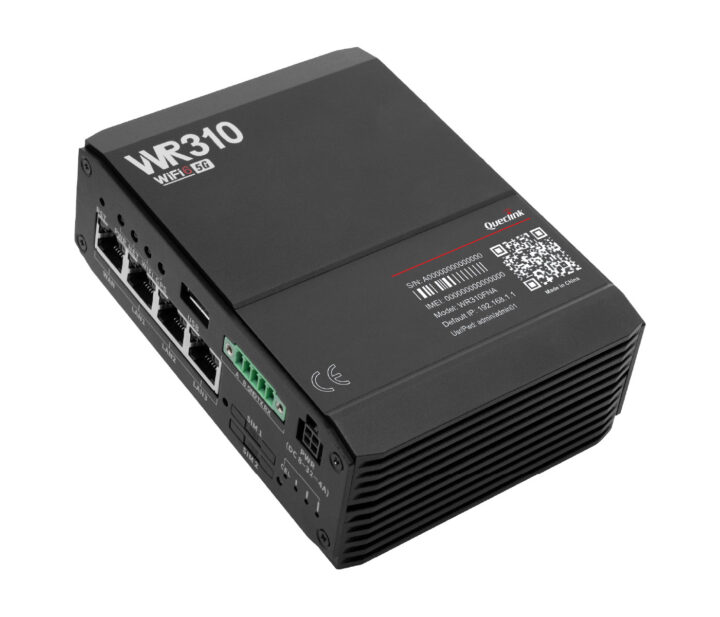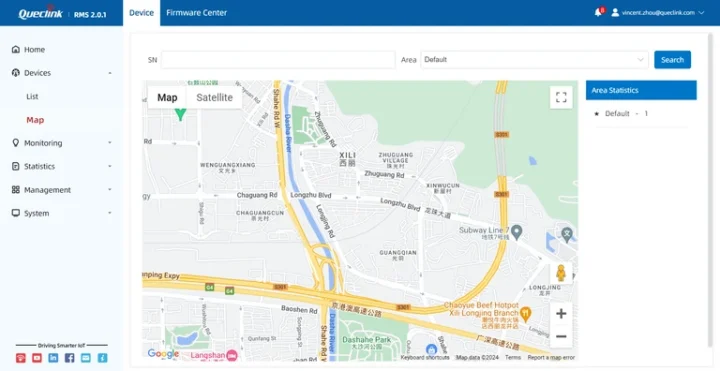Queclink WR310 5G and WiFi 6 industrial cellular router features four gigabit Ethernet ports, a USB Type-A port, a terminal block with RS232 and RS485, and a wide 8 to 32V DC input suitable for smart manufacturing, industrial IoT (IIoT), and edge computing applications.
It looks to be a more compact and cost-optimized version of the Queclink WR300 5G industrial router introduced in 2023 with global 5G coverage. The WR310 has many of the same features, but comes with less memory and storage, one less gigabit Ethernet port, and is available in three models depending on the region of operation:
- WR310FEU for EMEA, AP, and Brazil regions
- WR310FAU for LATAM markets
- WR310FNA for North America
Queclink WR310 specifications:
- SoC – Unspecified Qualcomm dual-core Arm 64-bit Cortex-A53 @ 1.0GHz; likely the Qualcomm IPQ5018 or similar (Note the Qualcomm IPQ8072 quad-core Arm Cortex-A53 @ 2.2 GHz was used in the WR300 5G industrial router)
- System Memory – 256MB DDR4 RAM
- Storage – 256MB flash
- Wireless
- 5G NR
- WR310FNA
- 5G NR NSA: n2/n5/n7/n12/n13/n14/n25/n26/n29/n30/n38/n41/n48/n66/n70/n71/n77/n78
- 5G NR SA: n2/n5/n7/n12/n13/n14/n25/n26/n29/n30/n38/n41/n48/n66/n70/n71/n77/n78
- WR310FAU
- 5G NR NSA: n2/n5/n7/n8/n28/n38/n40/n66/n71/n78
- 5G NR SA: n2/n5/n7/n8/n28/n38/n40/n66/n71/n78
- WR310FEU
- 5G NR NSA: n1/n3/n5/n7/n8/n20/n28/n38/n40/n41/n75/n76/n77/n78
- 5G NR SA: n1/n3/n5/n7/n8/n20/n28/n38/n40/n41/n75/n76/n77/n78
- WR310FNA
- LTE – Cat 19 (Downlink) / Cat 18 (Uplink)
- WR310FNA
- LTE-FDD: B2/B4/B5/B7/B12/B13/B14/ B17/B25/B26/B29/B30/B66/B71
- LTE-TDD: B38/B41/B42/B43/B48
- WR310FAU
- LTE-FDD: B2/B4/B5/B7/B8/B26/B28/B66
- LTE-TDD: /B38/B40/B42/B43
- WR310FEU
- LTE-FDD: B1/B3/B5/B7/B8/B20/B28/B32
- LTE-TDD: B38/B40/B41/B42/B43
- WR310FNA
- 3G UMTS
- WR310FNA – N/A
- WR310FAU – WCDMA: B2/B4/B5
- WR310FEU – WCDMA: B1/B5/B8
- WiFi 6 – IEEE 802.11 a/b/g/n/ac/ax
- 2475 Mbps (5 GHz) and 591 Mbps (2.4 GHz) (MU-MIMO)
- Access Point (AP) and Station (STA) mode
- GNSS receiver
- Sensitivity – Cold start: -146 dBm; reacquisition: -156 dBm; tracking: -147 dBm
- Position Accuracy (CEP) – Autonomous: < 4.0m
- TTFF (Open Sky) – Cold start: 35s average; warm start: 28s average; hot start: 2s average
- Dual SIM card slot for cellular connectivity
- Antennas
- 4x SMA for 5G
- 3x RP-SMA for WiFi 2.4/5GHz
- GNSS SMA antenna
- 5G NR
- Ethernet – 4x Gigabit Ethernet ports (1x WAN, 3x LAN)
- Network Protocols
- TCP, UDP, IPv4, ICMP, NTP, DNS, HTTP, HTTPS, FTP, SSL v3, TLS, ARP, PPP, PPPoE, SSH, DHCP, Telnet, Modbus
- VPN
- OpenVPN clients and server support
- IPsec, GRE
- PPTP and L2TP clients and server support
- USB – 1x USB Type-A port
- Serial via terminal block
- RS232 (without RTS, CTS) supporting 300 to 115,200 bps baud rate
- RS485 half-duplex (2 wires) supporting 300 to 115,200 bps baud rate
- Expansion – 1 x digital input, 1 x digital output in 4-pin power connector
- Security
- Firewall
- Attack Prevention using DDOS DMZ, ports scan
- Wi-Fi Security – WPA-PSK, WPA2-PSK, AES
- Access Control – Data connection port filter, MAC address filter.
- Misc
- LED Indicators – Power, Net, WiFi, GNSS, mobile status, mobile signal strength, 2x WAN, 6x LAN
- Reset Button
- Power Supply – 8 to 32V DC via 4-pin industrial DC power connector
- Dimensions – 130 (W) x 100 (D) x 45 (H) mm (Exclude antenna connectors and mounting bracket)
- Weight – 552 grams
- Temperature Range – Operating: -30°C to 70°C; storage: -40°C to 85°C
The WR310 is said to run an OpenWrt-based Linux OS with a WEB UI for configuration. The datasheet has a screenshot with Queclink RMS 2.0.1 which stands for “Router Management System” and is described as an “all-in-one centralized control cloud platform” that “offers clear device status visibility and capabilities for alert, task management, and data analytics, all without on-site visits”.
The press release mentions that Queclink officially launched the WR310, but as is often the case for this type of hardware, pricing has not been made publicly available. More details about the WR310FEU, WR310FAU, and WR310FNA 5G industrial cellular routers can be found on the Queclink website.
Thanks to TLS for the tip.

Jean-Luc started CNX Software in 2010 as a part-time endeavor, before quitting his job as a software engineering manager, and starting to write daily news, and reviews full time later in 2011.
Support CNX Software! Donate via cryptocurrencies, become a Patron on Patreon, or purchase goods on Amazon or Aliexpress








no official openwrt support possible 🙁 (ath11k needs 512 minimum)